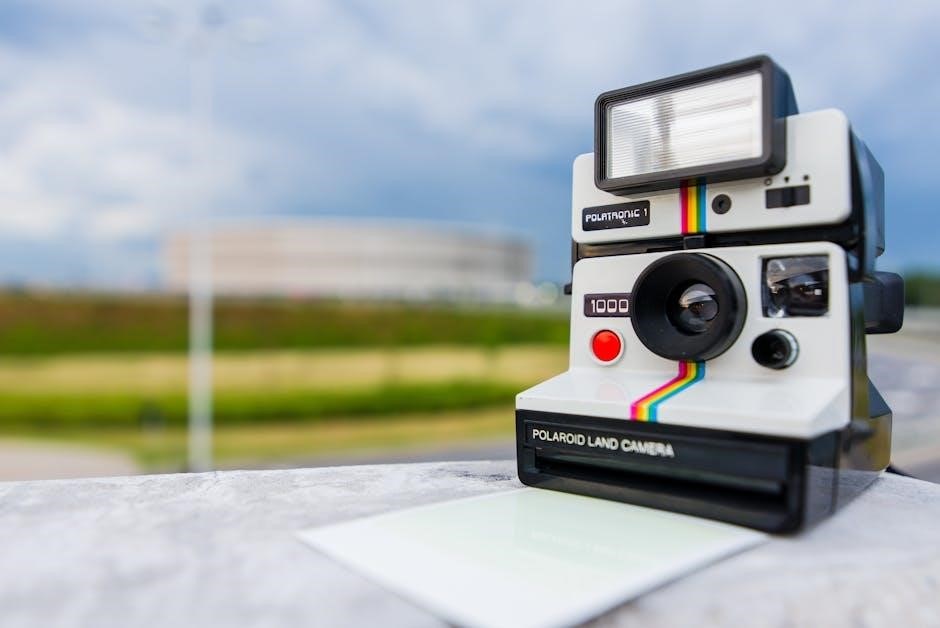polaroid snap owners manual
Welcome to the Polaroid Snap Owner’s Manual! This guide provides essential information to help you get started with your camera, understand its features, and troubleshoot common issues. Designed to enhance your instant photography experience, this manual covers everything from basic operations to advanced creative tools. Take your time to read through the sections to unlock the full potential of your Polaroid Snap and capture life’s special moments with ease and creativity.
1.1 Overview of the Polaroid Snap Camera
The Polaroid Snap is an instant print digital camera designed for capturing and printing 5MP photos instantly. It features a built-in memory for storing images and an SD card slot for expanded storage. The camera offers creative modes like double exposure and light painting, along with a self-timer for group shots. With its compact design and intuitive controls, the Polaroid Snap combines modern technology with the classic charm of instant photography. For detailed specifications, refer to the official manual available online.
1.2 Importance of Reading the Manual
Reading the Polaroid Snap owner’s manual is essential for understanding the camera’s features, operation, and maintenance. It provides step-by-step guidance for setup, usage, and troubleshooting, ensuring optimal performance; The manual highlights safety precautions, helping you avoid potential damage or hazards. By familiarizing yourself with the instructions, you can unlock the camera’s full potential, explore advanced modes, and resolve common issues efficiently; This knowledge enhances your photography experience and helps you create lasting memories with your Polaroid Snap;
1.3 Safety Precautions
To ensure safe and optimal use of your Polaroid Snap, follow these precautions. Avoid exposing the camera to extreme temperatures, moisture, or direct sunlight for extended periods. Handle the lens with care to prevent scratches or damage. Use only Polaroid-approved chargers and batteries to avoid electrical issues. Keep the camera out of reach of children and pets. Do not drop the camera or apply excessive force, as this may cause internal damage. Follow all instructions carefully to maintain performance and longevity.
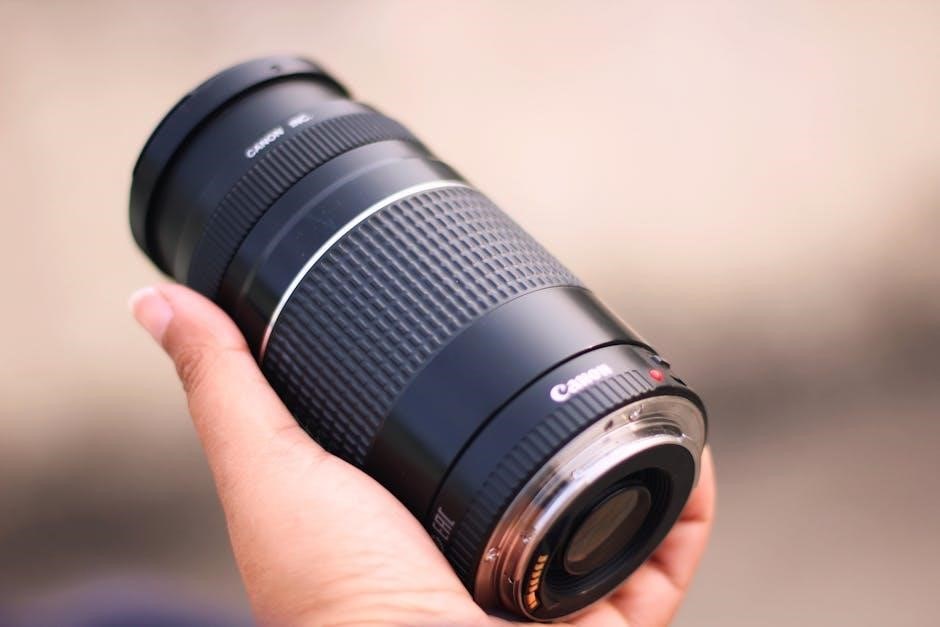
Unboxing and Initial Setup
Unboxing your Polaroid Snap, ensure all components are included. Carefully remove the camera from the packaging and inspect for any visible damage. Proceed to charge the battery fully before initial use. Familiarize yourself with the camera’s buttons and ports. Insert the provided SD card or one of your choice. Power on the camera and follow the on-screen prompts to complete the setup process. Refer to the manual for detailed guidance.
2.1 What’s in the Box
Your Polaroid Snap box contains the camera, a rechargeable lithium-ion battery, a micro USB charger, a wrist strap, and a user manual. Additionally, you may find a starter SD card to get you began with storage. Ensure all items are included and undamaged. The camera itself features a compact design, while the wrist strap provides convenience for on-the-go use. The micro USB charger supports easy battery charging via a computer or wall adapter. Refer to the manual for details on each component and its function;
2.2 Charging the Battery
To charge your Polaroid Snap, use the provided micro USB charger. Connect the USB end to a power source and the micro USB end to the camera’s port. The battery typically takes 2-3 hours to fully charge. A flashing LED indicates charging, while a steady light signals completion. Avoid overcharging to preserve battery life. Use only the supplied charger to ensure safety and compatibility. Keep the camera away from extreme temperatures during charging for optimal performance.
2.3 Inserting the SD Card
To insert the SD card into your Polaroid Snap, locate the SD card slot on the camera’s side. Open the slot by sliding it gently. Insert the SD card with the label facing up and the cut corner oriented correctly. Push the card in until it clicks securely. Ensure the card is fully inserted to avoid damage. The camera will recognize the SD card automatically. If it doesn’t, turn the camera off and on again. Use a Class 10 or higher SD card for optimal performance, up to 128GB. Always format the SD card in the camera or on a computer before use.
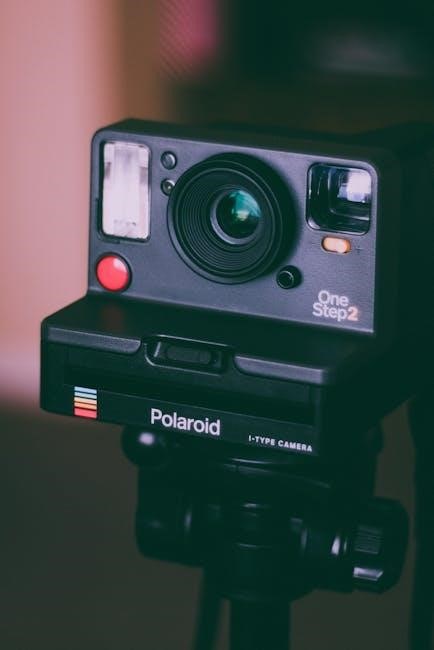
Camera Components and Controls
The Polaroid Snap features a user-friendly design with a lens, flash, and intuitive buttons for power, shutter, and mode selection. The LCD screen displays settings and previews, while the top panel includes controls for adjusting brightness and zoom. The camera’s compact body houses essential components for seamless photography and instant printing experiences.
3.1 Front Panel Features
The front panel of the Polaroid Snap houses the camera lens, flash, and selfie mirror, designed for easy self-portraits. The lens captures high-quality images, while the flash illuminates low-light scenes. The selfie mirror helps frame perfect self-portraits. These features ensure a seamless and intuitive photography experience, making the front panel a hub for essential camera functions.
3.2 Top Panel Controls
The top panel of the Polaroid Snap features essential controls for quick access to camera functions. The power button is located on the far right, followed by the shutter button for capturing photos. The mode dial allows switching between photo, video, and other modes. Additionally, the zoom buttons (+/-) enable easy adjustment of the focal length. These controls are intuitively designed to streamline your shooting experience, ensuring smooth navigation and efficient operation of the camera.
3.3 LCD Screen Overview
The Polaroid Snap’s LCD screen is a vibrant, color display located on the rear of the camera. It allows users to preview images, adjust settings, and navigate through menus effortlessly. The screen provides a clear view for framing shots and reviewing captured photos. Its intuitive interface enhances the overall user experience, making it easy to manage camera functions. Additionally, the LCD screen supports touch operations, enabling quick access to various features. This feature is essential for ensuring your photos meet your expectations.

Basic Camera Operations
This section covers essential camera functions, including taking photos, using the flash, and setting the self-timer. It provides a foundation for capturing great images effortlessly.
4.1 Taking Your First Photo
Start by turning on the Polaroid Snap and ensuring it is properly loaded with film. Align the yellow stripe on the film pack with the camera’s slot for correct installation. Aim the lens at your subject, compose the shot, and press the shutter button. The flash will automatically activate in low-light conditions. After capturing, the photo will eject and begin developing. Avoid direct sunlight on the lens to prevent glare; Allow a few minutes for the image to fully develop before handling it.
4.2 Understanding the Flash
The Polaroid Snap features a built-in flash to enhance photos in low-light conditions. The flash automatically activates when the camera detects insufficient light. For creative control, you can disable it by pressing and holding the flash button until the indicator light turns off. The flash recycles quickly, ensuring minimal wait time between shots. Avoid obstructing the flash lens for optimal performance. Using the flash indoors or outdoors can significantly improve image brightness and clarity.
4.3 Using the Self-Timer
To use the self-timer on your Polaroid Snap, press the timer button located on the top panel. The camera offers a 2-second, 5-second, or 10-second delay. Once activated, the timer indicator will flash on the LCD screen, and a beep will sound during the countdown. Position yourself in the frame and wait for the timer to complete. The camera will automatically capture the photo. You can cancel the timer at any time by pressing the timer button again. This feature is ideal for group shots or ensuring everyone is ready before shooting.
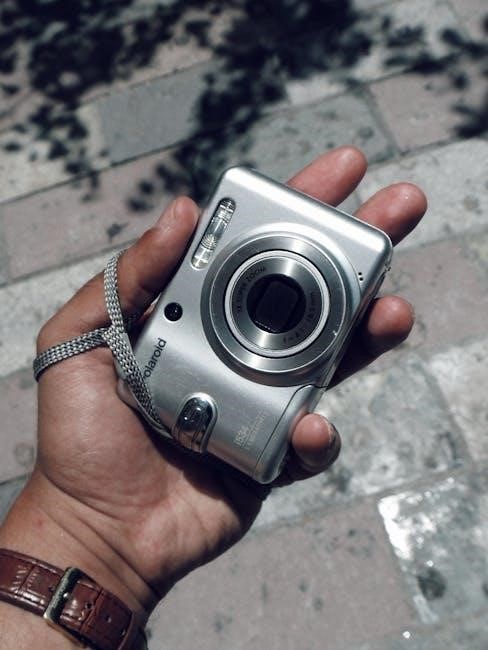
Printing Options and Features
The Polaroid Snap offers instant printing with ZINK Zero Ink Technology, producing vibrant, full-color photos. Customize print settings like brightness and saturation for desired results.
5.1 Instant Printing Basics
The Polaroid Snap allows you to print photos instantly using ZINK Zero Ink Technology. Simply press the print button, and your photo will be printed in seconds. Ensure the camera has paper loaded and is set to print mode. The ZINK paper is smudge-proof and water-resistant, producing vibrant, full-color images. Always check the paper tray to confirm it’s not empty before printing. Instant printing is a key feature, making the Polaroid Snap ideal for capturing and sharing memories immediately.
5.2 Adjusting Print Settings
To customize your prints, adjust settings like brightness and contrast using the camera’s menu. You can also enable features such as date stamps or filters. Navigate to the print settings menu via the LCD screen, then use the directional buttons to modify options. Ensure the settings match your preferences before printing. Experiment with different configurations to achieve the desired look for your photos. These adjustments enhance the quality and personalization of your instant prints, making each one unique and tailored to your creativity.
5.3 Using the Polaroid Print App
The Polaroid Print App allows you to print photos directly from your smartphone. Download and install the app from the App Store or Google Play. Ensure your camera is paired via Bluetooth. Open the app, select the photos you wish to print, and adjust settings like brightness and filters. Preview your images before printing. The app also supports multiple print sizes. Use this feature to enhance your instant printing experience and enjoy wireless convenience for creating physical copies of your favorite memories.
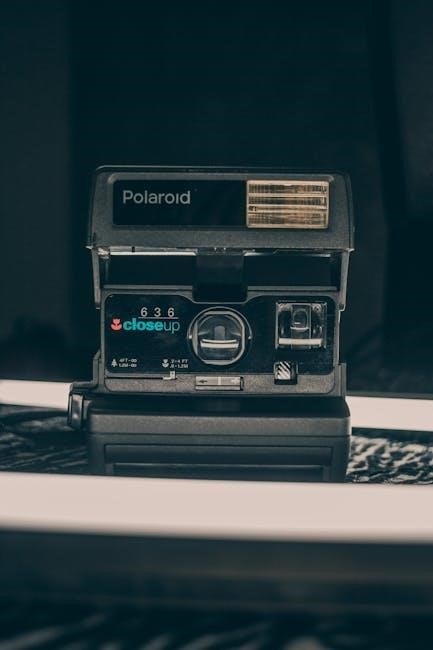
Advanced Camera Features
Discover advanced modes like double exposure, aperture priority, and light painting. These features offer creative control, enabling unique and artistic photo captures with the Polaroid Snap.
6.1 Double Exposure Mode
Double Exposure Mode allows you to capture two images in a single frame, creating unique, layered compositions. To activate, select the mode via the camera’s menu or mode dial. Frame your first shot, press the shutter, then frame the second image. The camera will combine both into one photo. Experiment with contrasting scenes or textures for artistic effects. Review the merged image on the LCD screen before printing. This feature is perfect for creative experimentation and capturing storytelling moments in a single frame.
6.2 Aperture Priority
Aperture Priority mode allows you to manually set the aperture value, giving you control over depth of field. The camera automatically adjusts the shutter speed to ensure proper exposure. Access this mode through the menu or by using the dedicated aperture control. The Polaroid Snap offers aperture settings from f/2.2 to f/10. A lower f-stop (e.g., f/2.2) creates a shallower depth of field, blurring backgrounds, while a higher f-stop (e.g., f/10) keeps more of the image in focus. Use this feature to enhance creativity in portraits and landscapes. Experiment with settings to achieve desired effects, and preview results on the LCD screen before capturing. This mode is ideal for photographers seeking more artistic control over their shots.
6.3 Light Painting Mode
Light Painting Mode captures artistic effects by extending exposure time, ideal for creative light trails. Activate this mode via the menu or mode dial. The camera uses a long exposure to record light movements. For best results, use a tripod in low-light conditions to avoid blur. Experiment with moving light sources like vehicles or glow sticks. Adjust exposure settings to achieve desired effects. This mode is perfect for capturing unique, artistic imagery.

Memory and Storage Management
The Polaroid Snap features built-in memory and supports SD cards for expanded storage. Manage photos efficiently by organizing files and transferring them to devices for backup.
7.1 Built-in Memory Capacity
The Polaroid Snap has a limited built-in memory capacity, suitable for temporary photo storage. It can store up to 10-15 photos, depending on file size. For extended use, an SD card is recommended to expand storage. Regularly transfer photos to a computer or SD card to free up space and ensure smooth camera operation. This built-in memory is designed for quick access and should be managed alongside external storage for optimal performance.
7.2 Managing Photos on SD Card
The Polaroid Snap allows you to store photos on an SD card, enabling easy organization and access. Use the camera’s LCD screen to view and delete photos directly from the card. To free up space, delete unwanted images or transfer them to a computer. The SD card is essential for storing a large number of photos, as the camera relies on it for extended memory. Properly managing your SD card ensures efficient photo storage and quick access to your favorite shots.
7.4 Transferring Photos to a Computer
To transfer photos from your Polaroid Snap to a computer, use a USB cable or remove the SD card and insert it into a card reader. Connect the camera directly via USB, and the computer should recognize it as a storage device; Alternatively, use a USB card reader for the SD card. Once connected, your computer will display the photos, allowing you to copy or drag-and-drop them to your desired folder. This method ensures your photos are safely backed up and organized on your computer for easy access and sharing.
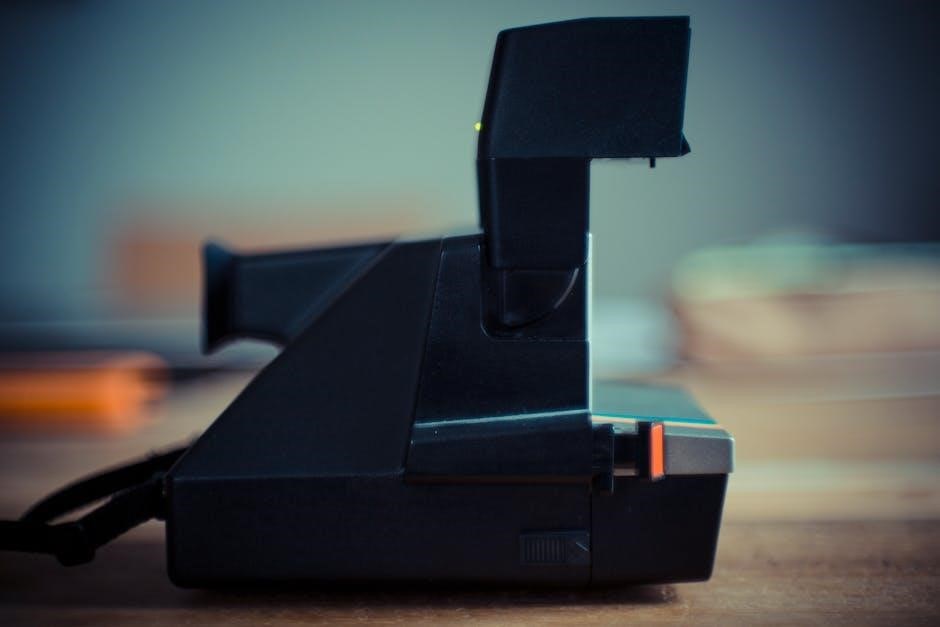
Connectivity and Bluetooth Features
The Polaroid Snap supports Bluetooth connectivity, enabling wireless communication with compatible devices. This feature allows seamless pairing with smartphones and tablets via the Polaroid app.
8.1 Pairing with the Polaroid App
To pair your Polaroid Snap with the Polaroid App, ensure Bluetooth is enabled on your camera and smartphone. Download and install the Polaroid App from the App Store (iOS) or Google Play Store (Android). Open the app and select your camera model. Follow the on-screen instructions to complete the pairing process. Ensure your camera is fully charged and in Bluetooth mode. Once connected, you can remotely control the camera, adjust settings, and transfer photos. Verify firmware updates are installed for optimal functionality.
8.2 Remote Control via Smartphone
The Polaroid Snap allows you to control the camera remotely using the Polaroid Print App on your smartphone. Once paired, you can trigger the shutter, adjust settings, and even view photos on your phone. This feature is ideal for group shots or tripod-based photography. Ensure your camera is connected to the app via Bluetooth, and follow in-app instructions to enable remote control. This convenience reduces camera shake and enhances your creative flexibility while shooting.
8.3 Updating Firmware
Regular firmware updates ensure your Polaroid Snap performs optimally. To update, open the Polaroid app and pair your camera via Bluetooth. Navigate to the settings menu and select “Firmware Update.” If an update is available, follow the on-screen instructions to download and install it. Ensure the camera is fully charged before starting. Do not turn off the camera or disconnect Bluetooth during the update process. Once complete, restart the camera to apply the new firmware.
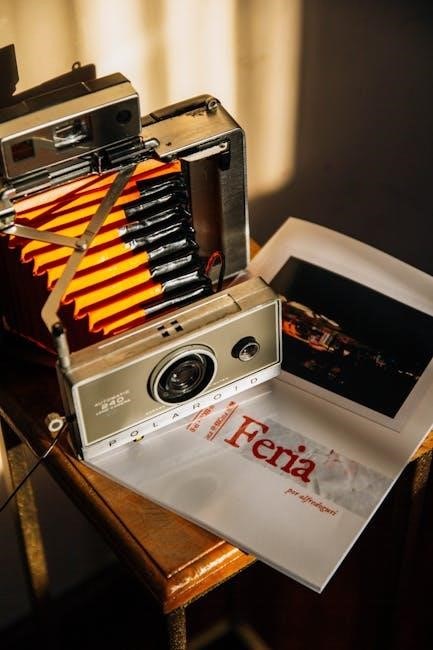
Troubleshooting Common Issues
Identify and resolve issues like battery drain, print failures, or connectivity problems. Check power settings, paper jams, and ensure proper Bluetooth pairing for seamless functionality.
Battery Issues: Restart the camera or charge fully.
Print Failures: Ensure paper is aligned and ink levels are sufficient.
Connectivity: Disable and re-enable Bluetooth on both devices.
9.1 No Power or Battery Issues
If your Polaroid Snap won’t turn on, ensure the battery is fully charged. Use the provided USB cable and charger, and avoid third-party adapters. Allow the camera to charge for at least 30 minutes. If it still doesn’t power on, try resetting it by pressing and holding the power button for 10 seconds. Check for loose connections or damage to the charging port. If issues persist, contact Polaroid support for assistance. Always use genuine accessories to maintain functionality.
9.2 Printing Problems
If your Polaroid Snap is experiencing printing issues, start by ensuring the paper is loaded correctly and the print head is clean. Check for any obstructions or jams in the paper path. If prints are blank or faded, verify the ink levels and ensure the print settings are configured properly. Restarting the camera or resetting it to factory settings may resolve unexpected errors. For persistent issues, refer to the user manual or contact Polaroid support for assistance.
- Check paper alignment and ink levels.
- Clear any paper jams gently.
- Restart the camera to reset functions.
9.3 Connectivity Issues
If you encounter issues with Bluetooth connectivity, ensure your camera and device are properly paired. Restart both devices and check for firmware updates. Resetting the connection by turning Bluetooth off and on can often resolve pairing problems. Verify that your smartphone has the latest Polaroid app version installed. If issues persist, perform a factory reset on the camera. For additional help, refer to the troubleshooting section in the app or contact Polaroid support.
- Reset the connection by turning Bluetooth off and on.
- Ensure the Polaroid app is up to date.
- Restart both the camera and smartphone.
Maintenance and Care
Regularly clean the camera with a microfiber cloth to avoid smudges.
Store in a dry, cool place, protect the lens and battery during storage.
10.1 Cleaning the Camera
To keep your Polaroid Snap in great condition, regular cleaning is essential. Use a soft, dry microfiber cloth to gently wipe the exterior and lens. For stubborn smudges, lightly dampen the cloth with distilled water, but avoid liquids touching electrical parts. Never use harsh chemicals, abrasive materials, or spray cleaners, as they may damage the camera’s finish or harm the lens coating. For dust in small crevices, use compressed air cautiously. Cleaning your camera regularly ensures optimal performance and image quality. Store it in a protective case when not in use to prevent scratches and dust buildup.
10.2 Protecting the Lens
Protecting the lens is crucial for maintaining image quality. Always use a lens cap when not in use to prevent scratches and dust. Avoid touching the lens surface, as oils from skin can leave smudges. Clean the lens gently with a microfiber cloth and avoid harsh chemicals. Never expose the lens to direct sunlight for extended periods, as it may cause damage. Store the camera in a protective case to minimize accidental damage. Regular maintenance ensures optimal performance and longevity of your Polaroid Snap camera.
- Use a lens cap to prevent scratches.
- Clean with a microfiber cloth only.
- Avoid direct sunlight exposure.
- Store in a protective case.
10.3 Storing the Camera
To maintain your Polaroid Snap’s condition, store it in a cool, dry place away from direct sunlight. Use the original case or a protective bag to prevent scratches and dust accumulation. Avoid exposure to extreme temperatures or humidity, as this can damage the internal components. When storing for extended periods, remove the battery to prevent leakage. Keep the camera away from children and pets to avoid accidental damage. For added protection, consider using silica gel packets to control humidity levels.
Warranty and Support
The Polaroid Snap comes with a one-year limited warranty covering manufacturing defects. For support, visit Polaroid Support. Register your camera and keep the proof of purchase for warranty claims. Contact their team for any inquiries or issues.
- Warranty period: 1 year from purchase date.
- Covers defects in materials and workmanship.
- Proof of purchase is required for warranty service.
11.1 Warranty Information
The Polaroid Snap camera comes with a limited warranty that covers manufacturing defects for a specified period, typically one year from the date of purchase. The warranty includes repairs or replacements for faulty components at no additional cost. To be eligible, the camera must have been purchased from an authorized retailer, and the original receipt must be provided. Damage caused by misuse, accidents, or unauthorized modifications is not covered under the warranty. Proper registration of the product is recommended to ensure warranty validity.
For detailed terms and conditions, refer to the warranty card included in the packaging or visit the official Polaroid website. It is important to retain the proof of purchase and adhere to all warranty guidelines to avoid voiding the coverage. If you encounter any issues within the warranty period, contact Polaroid support for assistance.
11.2 Contacting Polaroid Support
If you encounter issues or have questions about your Polaroid Snap, contacting Polaroid Support is straightforward. Visit the official Polaroid website and navigate to the “Support” section. Here, you can find contact information, including phone numbers, email addresses, and live chat options. Support is available Monday through Friday, 9 AM to 5 PM EST. Ensure you have your camera’s model and serial number ready for faster assistance. Additionally, the website offers a comprehensive FAQ section and downloadable resources to help troubleshoot common problems.
11.3 Repair Options
Your Polaroid Snap comes with repair options to ensure longevity. For warranty repairs, contact Polaroid Support for authorization. Out-of-warranty repairs can be handled by authorized service centers. Visit the official website for a list of centers. Always use genuine parts to maintain performance. For assistance, reach out via phone, email, or live chat. The support team will guide you through the repair process, ensuring your camera is restored to optimal condition.
Congratulations on completing the Polaroid Snap Owner’s Manual! You’re now ready to unlock your creativity and capture life’s moments with ease. Happy snapping!
12.1 Final Tips for Getting the Most Out of Your Polaroid Snap
To maximize your Polaroid Snap experience, experiment with its creative modes like Double Exposure and Light Painting. Regularly clean the lens and protect it from scratches. Store the camera in a dry, cool place when not in use. Explore the Polaroid Print App for enhanced printing options and sharing features. Don’t forget to update firmware for the latest improvements. Most importantly, have fun and embrace the unique instant photography experience that the Polaroid Snap offers. Happy snapping!
12.2 Encouragement to Experiment and Create
Don’t be afraid to explore and push the boundaries of your Polaroid Snap! Experiment with different modes like Double Exposure or Light Painting to create unique, artistic photos. The instant printing feature allows you to share moments immediately, making it a great tool for creativity. Try new techniques, play with lighting, and capture life’s unexpected beauty. Remember, the best photos often come from stepping out of your comfort zone. Enjoy the journey of discovery and make every snap a memory to cherish.

FAQs
13.1 Common Questions About the Polaroid Snap
- Q: How long does the battery last? A: The battery lasts up to 25 prints on a full charge.
- Q: What SD cards are compatible? A: Use Class 10 SD cards up to 128GB for optimal performance.
- Q: Why is print quality poor? A: Check ink levels, clean the print head, and ensure proper paper alignment.
- Q: Can I connect to multiple devices? A: No, pair with only one device at a time via Bluetooth.
Users often ask about the Polaroid Snap’s battery life, which typically lasts for 15-20 prints. Another common query is how to improve print quality, with solutions including proper paper alignment and cleaning the print head. Many wonder if the camera supports SD cards up to 128GB, which it does. Questions about paper jams are frequent, and restarting the camera usually resolves this. Finally, users often inquire about app connectivity issues, which can be fixed by ensuring Bluetooth is enabled and the app is updated.
- How long does the battery last?
- Why are my prints blurry?
- Can I use a 128GB SD card?
- How do I fix a paper jam?
- Why won’t the app connect to my camera?
For detailed solutions, refer to the respective sections in this manual.
13.2 Solutions to Frequently Encountered Problems
For paper jams, turn off the camera, locate the jam, and gently pull the paper out. Blurry photos? Clean the lens with a soft cloth and ensure proper focus. If the camera won’t turn on, charge the battery for at least 30 minutes. For connectivity issues, restart the camera and smartphone, then reconnect via Bluetooth. Print quality issues? Check ink levels and ensure the paper is loaded correctly. Visit the Polaroid support website for detailed troubleshooting guides and firmware updates.

